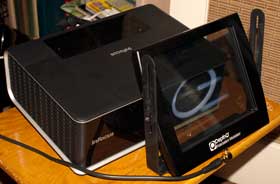The DepthQ Polarization Modulator - an Overview
Lightspeed's DepthQ polarization modulator is a stand alone device that can be placed in front of a variety of projectors that are capable of at least 120hz output. In our review, we used the modulator in conjunction with already 3D projectors - lower end, single chip projectors. Now, normally, such 3D projectors use active shutter glasses, and work with good conventional screens (some are better than others, though).
The other way of doing 3D with projectors, is to polarize the image, using a screen designed to work well with the two different polarized images (generally 3D labeled screens), and then view using inexpensive passive glasses.
The DepthQ allows a projector capable of working with the first type - active shutter glasses, to instead work with polarized screen and passive glasses. You end up spending for the screen, but save a bundle on the glasses, especially if you need a whole lot of them, say, for a classroom. Projectors that are not necessariily 3D may also work with the Polarization Modulator, as the Modulator's controller apparently handle the 3D processing.
Another advantage, is that passive glasses 3D systems (which, confusingly, work with active 3D projectors), are brighter. According to my conversation with the Lightspeed folks, active glasses systems typically lose over 80% of the light. That is, the average amount of light hitting your eyeballs. By comparison, passive solutions usually "only" lose about 2/3 of the light. That makes passive glasses systems potentially almost twice as bright, if you are starting with two projectors with similar brightness, one active, one passive 3D.
In other words, one rationale for a DepthQ Modulator is cost, another is brightness. In fairness though, the DepthQ Modulator is expensive. It's cost is roughly in the same ballpark, today, as buying a couple to three dozen active shutter glasses, and you will need a 3D screen, but, for larger audiences (25+) the Lightspeed DepthQ Modulator is likely to offer you an overall less expensive solution than going with passive single chip DLP projectors, and a whole lot of active shutter glasses. Other avantages, include the potential extra expense that passive projectors/active glasses require in larger rooms, to get the syncing signal to all the glasses in the room. The typical system so far, tends to run out of signal strength at about 30-35 feet, based on my experiences with active shutter glasses, at CEDIA. Now some classrooms will be deeper than that, as well as training rooms, multi-purpose rooms, small auditoriums, hotel ballrooms, basically just about any type of room suitable for presentations, that's bigger than a typical sized conference room.


